
Moeritherium is an extinct genus of primitive proboscideans. These prehistoric mammals are related to the elephant and, more distantly, sea cows and hyraxes. They lived during the Eocene epoch.
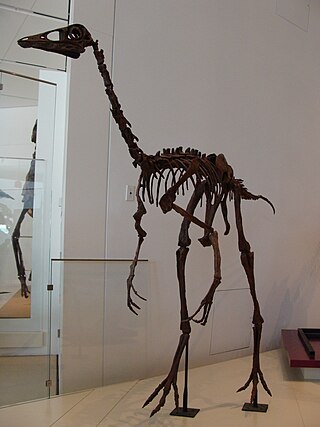
Ornithomimus is a genus of ornithomimid theropod dinosaurs from the Campanian and Maastrichtian ages of Late Cretaceous Western North America. Ornithomimus was a swift, bipedal dinosaur which fossil evidence indicates was covered in feathers and equipped with a small toothless beak that may indicate an omnivorous diet. It is usually classified into two species: the type species, Ornithomimus velox, and a referred species, Ornithomimus edmontonicus. O. velox was named in 1890 by Othniel Charles Marsh on the basis of a foot and partial hand from the Denver Formation of Colorado. Another seventeen species have been named since then, though almost all of them have been subsequently assigned to new genera or shown to be not directly related to Ornithomimus velox. The best material of species still considered part of the genus has been found in Alberta, representing the species O. edmontonicus, known from several skeletons from the Horseshoe Canyon Formation. Additional species and specimens from other formations are sometimes classified as Ornithomimus, such as Ornithomimus samueli from the earlier Dinosaur Park Formation.
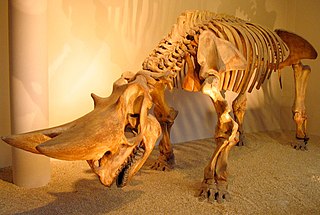
Arsinoitherium is an extinct genus of paenungulate mammals belonging to the extinct order Embrithopoda. It is related to elephants, sirenians, and hyraxes. Arsinoitheres were superficially rhinoceros-like herbivores that lived during the Late Eocene and the Early Oligocene of North Africa from 36 to 30 million years ago, in areas of tropical rainforest and at the margin of mangrove swamps. A species described in 2004, A. giganteum, lived in Ethiopia about 27 million years ago.

Xiphactinus, colloquially referred to as the X-fish, is an extinct genus of large predatory marine bony fish that lived during the late Albian to the late Maastrichtian. The genus grew up to 5–6 metres (16–20 ft) in length, and superficially resembled a gargantuan, fanged tarpon.

Uintatherium is an extinct genus of herbivorous dinoceratan mammal that lived during the Eocene epoch. Two species are currently recognized: U. anceps from the United States during the Early to Middle Eocene and U. insperatus of Middle to Late Eocene China.
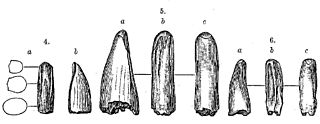
Aublysodon is a genus of carnivorous dinosaurs known only from the Judith River Formation in Montana, which has been dated to the late Campanian age of the late Cretaceous period. The only currently recognized species, Aublysodon mirandus, was named by paleontologist Joseph Leidy in 1868. It is sometimes considered dubious now, because the type specimen consists only of an isolated premaxillary (front) tooth. Although this specimen is now lost, similar teeth have been found in many US states, western Canada, and Asia. These teeth almost certainly belong to juvenile tyrannosaurine tyrannosaurids, but most have not been identified to species level. However, it is likely that the type tooth belongs to one of the species in the genus Daspletosaurus, which was present in contemporary formations, and which matches specific details of the original tooth. The synapomorphies alleged to distinguish the Aublysodontinae, especially lack of serrations on premaxillary teeth could have been caused by tooth wear in life, postmortem abrasion, or digestion. Most other "aublysodontine"-type teeth may be from ontogenetic stages or sexual morphs of other tyrannosaurids.
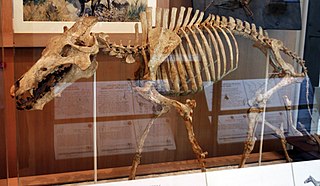
Archaeotherium is an extinct genus of entelodont artiodactyl endemic to North America during the Eocene and Oligocene epochs (35—28 mya), existing for approximately 9.1 million years. Archaeotherium fossils are most common in the White River Formation of the Great Plains, but it has also been found in the John Day Basin of Oregon and the Trans-Pecos area of Texas.
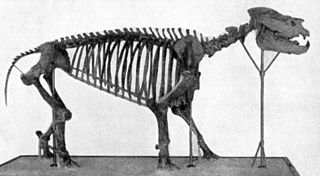
Metamynodon is an extinct genus of amynodont that lived in North America and Asia from the late Eocene until early Oligocene, although the questionable inclusion of M. mckinneyi could extend their range to the Middle Eocene. The various species were large, displaying a suit of semiaquatic adaptations more similar to those of the modern hippopotamus, despite their closer affinities with rhinoceroses.

Poebrotherium is an extinct genus of camelid, endemic to North America. They lived from the Eocene to Miocene epochs, 46.3—13.6 mya, existing for approximately 32 million years.

Oxyaena is an extinct genus of placental mammals from extinct subfamily Oxyaeninae within extinct family Oxyaenidae, that lived in Europe, Asia and North America during the early Eocene.

Megacerops is an extinct genus of the prehistoric odd-toed ungulate family Brontotheriidae, an extinct group of rhinoceros-like browsers related to horses. It was endemic to North America during the Late Eocene epoch, existing for approximately 4.1 million years.
Limenavis is a prehistoric bird genus from the Late Cretaceous. It lived about 70 million years ago, around the Campanian-Maastrichtian boundary. Known from several broken bones, the remains of the only known species Limenavis patagonica were found in rocks of the "lower member" of the Allen Formation at Salitral Moreno, 20 km south of General Roca, Río Negro (Argentina). It is the closest relative, in the fossil record, of the modern birds.

Hadrianus is an extinct genus of tortoise belonging to the Testudinidae found in the United States, the Yolomécatl Formation of Mexico, the Alai Beds of Kyrgyzstan and Spain and believed to be the oldest true tortoise known. The genus is thought to be closely related to the genus Manouria. The genus may have evolved in the subtropics of Asia and subsequently migrated to North America and Europe. Evangelos Vlachos (2018) reassessed the North American species attributed to the genus, and determined only two as accepted namely H. corsoni & H. majusculus. The remaining species were identified as either junior synonyms, moved to other genera or considered nomen dubium do to incomplete fossils.

Phareodus is a genus of freshwater fish from the Paleocene to the Eocene of Australia, Europe and North and South America.

Sinopa is an extinct genus of placental mammals from extinct family Sinopidae within extinct order Hyaenodonta, that lived in North America and Asia from the early to middle Eocene.

Saniwa is an extinct genus of varanid lizard that lived during the Eocene epoch. It is known from well-preserved fossils found in the Bridger and Green River Formations of Wyoming, United States. The type species S. ensidens was described in 1870 as the first fossil lizard known from North America. A second species, S.orsmaelensis, is recognised from remains found in Europe. It is a close relative of Varanus, the genus that includes monitor lizards.
Bahndwivici is an extinct genus of lizard known from a nearly complete and articulated skeleton discovered in rocks of the Green River Formation of Wyoming, United States. The skeleton is very similar to that of the modern Chinese crocodile lizard, Shinisaurus.

Paleontology in New Mexico refers to paleontological research occurring within or conducted by people from the U.S. state of New Mexico. The fossil record of New Mexico is exceptionally complete and spans almost the entire stratigraphic column. More than 3,300 different kinds of fossil organisms have been found in the state. Of these more than 700 of these were new to science and more than 100 of those were type species for new genera. During the early Paleozoic, southern and western New Mexico were submerged by a warm shallow sea that would come to be home to creatures including brachiopods, bryozoans, cartilaginous fishes, corals, graptolites, nautiloids, placoderms, and trilobites. During the Ordovician the state was home to algal reefs up to 300 feet high. During the Carboniferous, a richly vegetated island chain emerged from the local sea. Coral reefs formed in the state's seas while terrestrial regions of the state dried and were home to sand dunes. Local wildlife included Edaphosaurus, Ophiacodon, and Sphenacodon.

Paleontology in the United States refers to paleontological research occurring within or conducted by people from the United States. Paleontologists have found that at the start of the Paleozoic era, what is now "North" America was actually in the southern hemisphere. Marine life flourished in the country's many seas. Later the seas were largely replaced by swamps, home to amphibians and early reptiles. When the continents had assembled into Pangaea drier conditions prevailed. The evolutionary precursors to mammals dominated the country until a mass extinction event ended their reign.

The Bridger Formation is a geologic formation in southwestern Wyoming. It preserves fossils dating back to the Bridgerian and Uintan stages of the Paleogene Period. The formation was named by American geologist Ferdinand Vandeveer Hayden for Fort Bridger, which had itself been named for mountain man Jim Bridger. The Bridger Wilderness covers much of the Bridger Formation's area.





















